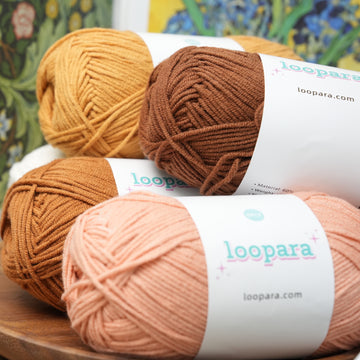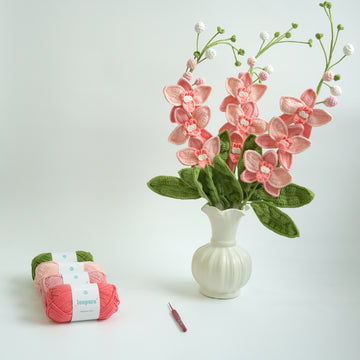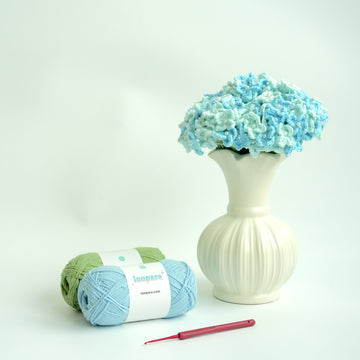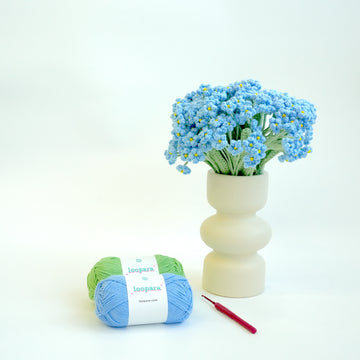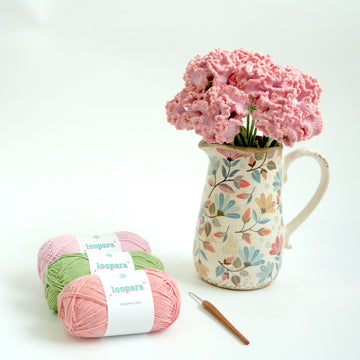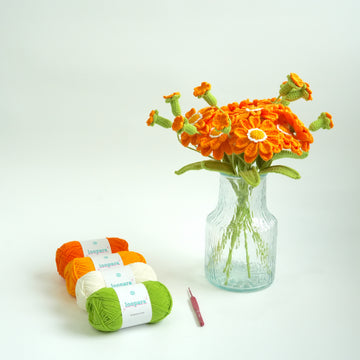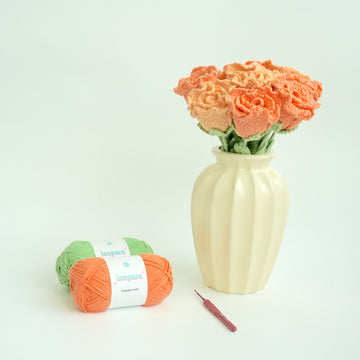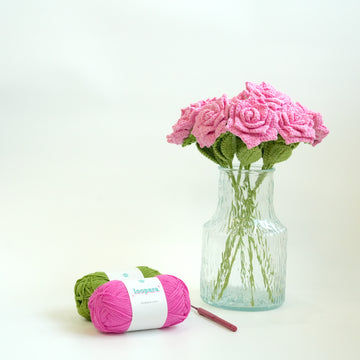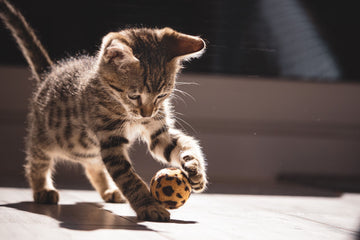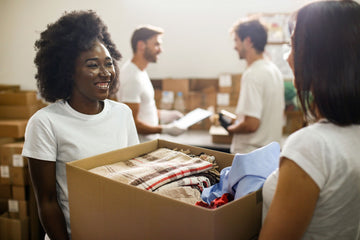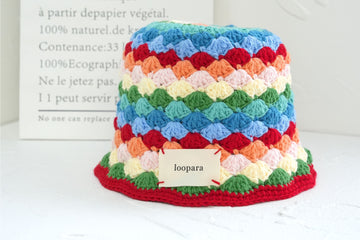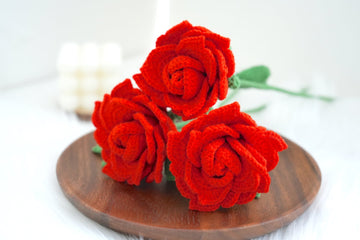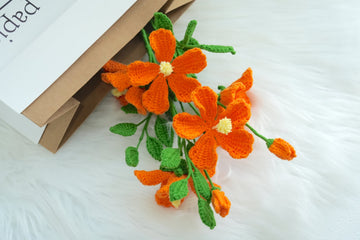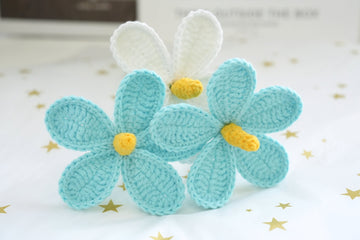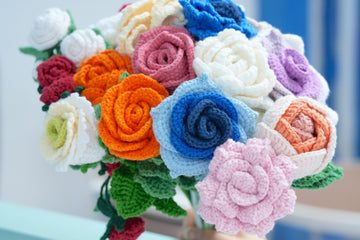When you’re learning to crochet, you’ll quickly start hearing about “gauge”. But what is gauge in crochet? And why does it matter?
We’re going to take you through everything you need to know. We’ll look at the kinds of projects where gauge is really important, and those where it doesn’t matter so much. And we’ll explain how you can vary the gauge in patterns – and why you might want to do that.
So if you’re ready, let’s get started!
What does “gauge” mean in crochet?
Gauge refers to the number of stitches and rows in a given area of crocheted fabric. It can be measured in stiches and rows per centimeter or per inch. And it’s used in patterns as a way of ensuring the finished item comes out the right size.
Gauge is affected by the weight of the yarn you’re using, the size of the crochet hook, and the tension – i.e. how tightly you’re holding the working yarn as you crochet.
The tighter your tension, the tighter your stitches will be, and the more of them will fit into an inch (or centimeter). For that reason, “gauge” is sometimes used interchangeably with “tension” particularly in the US.
When gauge matters
Crochet patterns will say what gauge you should work to. If you follow the recommended gauge, your item will turn out the same size as the pattern says it should.
If your gauge is looser – i.e. there are fewer stitches per inch than stated in the pattern – your item will end up bigger. If it’s tighter, your item will end up smaller.
That might not matter very much. If you’re making a small item, like crochet jewelry, there are unlikely to be many stitches. So a small difference in gauge is unlikely to make a huge difference overall.
Similarly, you might not be too worried if a scarf or blanket ends up a bit bigger or smaller than stated in the pattern.
But if you’re making a garment where fit is important, matching the gauge to the pattern is key. If you don’t, you can end up with a jumper you can’t fit over your head, or sleeves that finish at your elbows instead of your wrists!

Measuring gauge
Patterns will set out the gauge they use. That will usually be described as the number of stitches and rows in a particular area of fabric. It will look something like this:
Gauge: 4″ = 10 dc x 6 rows with 6.5mm hook.
This is telling you that a 4-inch square piece of the crocheted fabric should have 10 double crochet stitches across it, and six rows down. It’s also telling you to use a 6.5 mm hook.
To check your gauge, you’ll need to make what’s known as a gauge swatch. This is a small piece of fabric made using your chosen yarn, hook and pattern. Most pattern gauges use a sample 4 inches by 4 inches.
You can vary this if you like, but don’t make it too small. Gauge is affected by the tension with which you crochet, and that can vary slightly from stitch to stitch. Changes are particularly likely at the beginnings and ends of rows. So your swatch needs to be big enough for those variations to average out.
For that reason, it’s a good idea to make your swatch a bit larger than 4 inches by 4 inches. That way you can measure the stitches and rows in the middle part of the fabric, where your tension will be more consistent.
Once you’ve made your swatch, measure 4 inches across and count the number of stitches. Now measure 4 inches down and count the number of rows. You can now compare this to the numbers in the pattern you’re working from.
What to do if your gauge doesn’t match your pattern
If the numbers of stitches and rows in your gauge swatch match the pattern, congratulations! Your yarn, hook and tension combination are working together perfectly. And that means your finished item will be the same size and density as specified in the pattern.
But don’t worry if they’re not. If the exact size of the finished item doesn’t matter to you, you can go right ahead knowing there’ll be a difference. And if size is important, you can vary the gauge in a number of different ways:
- Adjust your tension. The tighter you hold the yarn as you crochet, the tighter your stitches will be. If your gauge swatch has more stitches than the pattern states, try to loosen up a bit. If your swatch has fewer stitches than the pattern, hold on a bit tighter.
- Change the weight of your yarn. Thicker yarn means each stitch will take up more room. So if you have more stitches in your gauge swatch than the pattern says you should, swapping for a thicker yarn will help. If your swatch has fewer stitches than it should, a thinner yarn will increase your stitch count.
- Change the size of your hook. Bigger hooks will create looser stitches, so each stitch has a larger surface area. If your swatch has more stitches than the pattern states, a bigger hook will help. If you need to pack in more stitches, swapping your hook for a smaller one will do that.
You can change one of these variables, or a combination. Note that if you keep the yarn weight the same and increase the hook size, your fabric will have a more open texture and a lacier appearance. If you use a smaller hook with the same weight of yarn, the fabric will be denser.
Whatever changes you make, your next step is to crochet another gauge swatch and check it against the pattern requirements. Keep making adjustments until the gauge matches up.

Using gauge to re-size patterns
You can also deliberately vary the gauge set out in a pattern if you want to change the size of your finished item. That will give you something that’s bigger or smaller, without requiring you to recalculate stitch or row numbers.
If you want to make your item bigger than stated in the pattern, you can increase the gauge by:
- loosening your tension
- using thicker yarn
- using a larger crochet hook.
Or if you want to scale down the item, decrease the gauge by:
- tightening your tension
- using thinner yarn
- using a smaller crochet hook.
To work out how much bigger or smaller your finished item will be, you’ll need to work up a gauge swatch. But in this case, instead of matching it to the gauge in the pattern, you’ll want to see how different it is.
The easiest way of doing this is to crochet the same number of stitches and rows stated in the pattern gauge. You can then measure the finished piece of fabric and see how much bigger or smaller it has come out.
Here’s an example of how you’d do it:
Your pattern says “Gauge: 4″ = 10 dc x 6 rows with 6.5mm hook”
You’d like your item to be smaller, so you decide to use a 4 mm hook instead. But you want the fabric to have a similar appearance and drape, so you reduce the yarn weight too.
You use the thinner yarn and smaller hook to crochet ten rows, each with 14 double crochet stitches. You do that so you can measure your swatch in the middle, where your tension is most consistent. (The exact number of stitches and rows you crochet doesn’t matter. It just needs to be more than the numbers in the pattern gauge.)
Now you count ten stitches across (discounting the stitches at the ends) and place a stitch marker at either end. You measure the distance between the markers, and it’s 3 inches.
Next, you count six rows down (discounting the ones at the top and bottom). Again, you mark the distance with stitch markers and measure between them. The distance there is 3 inches.
The gauge in the pattern measures 4 inches by 4 inches. The same number of stitches and rows in your gauge swatch is giving you a piece of fabric measuring 3 inches by 3 inches.
So now you know your item will be three-quarters the size (3 / 4) it would have been if you’d followed the pattern gauge.
Depending on how complicated the pattern is, you might have to make some other tweaks. If you’re making a three-dimensional object like amigurumi, for example, you might need to increase or decrease in different place and add or miss stitches.
But changing the gauge will still give you a good starting point to re-size your item.
What is gauge in crochet: A quickfire summary
Gauge in crochet means the number of stitches and rows in a given area of fabric. It’s closely related to tension, but can also be affected by yarn weight and hook size.
Sticking to the gauge in a pattern is important if you want your item to turn out exactly the same size as it states. In other words, it’s important for items like garments, less important for blankets or bookmarks.
Use a gauge swatch to check your gauge and adjust it if necessary.


